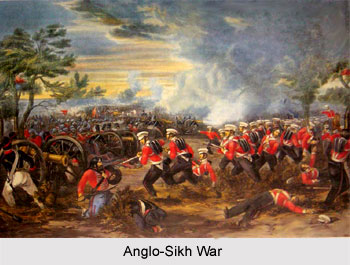 Second Anglo-Sikh War fell out between the Sikh Empire and the British Empire. The war led to the subjugation of the Sikh kingdom and the annexation of Punjab and what subsequently became the North-West Frontier Province by the British East India Company. Second Anglo-Sikh War was fought in 1848 and 1849 and this historic battle resulted in the conquest of the Sikh Empire. Further, it also led to the annexation of Punjab.
Second Anglo-Sikh War fell out between the Sikh Empire and the British Empire. The war led to the subjugation of the Sikh kingdom and the annexation of Punjab and what subsequently became the North-West Frontier Province by the British East India Company. Second Anglo-Sikh War was fought in 1848 and 1849 and this historic battle resulted in the conquest of the Sikh Empire. Further, it also led to the annexation of Punjab.
The presence of the English contingent at Lahore and their officers at all the outlying districts was not liked by the people. The feeling, however, remained hidden for a short while and came out soon after in the form of a large scale revolt. On 19th of April 1848, at the reception of a new Sikh governor replacing the Hindu Mulraj in Multan, the local Sikhs had wrecked havoc on the oppressors by severe attack. They gravely injured English lives and in consequence, Multan passed into a state of rebellion under the leadership of the Mulraj of Multan. Inadvertently, Mulraj, the diwan of Multan, caused the rise of this popular uprising. Events moved at a fast pace.
During the transfer of power the Muslim sepoys of Mulraj attacked and injured these officers. The officers then left the fort and camped outside the town. The next day the Sikhs attacked the English officers. The whole escort of the Khalsa army also went over to Mulraj. Meanwhile local commanders took matters in their hands. Lieutenant Edwardes advanced towards Multan with a small force. On the way he crossed the Indus River and Chenab River and fought a number of engagements until he reached Multan by the end of July 1848. Mulraj was now confined to the fort. A force under Genera] Whisk then marched on Multan. While this was in progress there was further defection in the English camp. Raja Sher Singh with his whole force of 3,500 Sikhs went over to Mulraj on September 14. This reverse caused the English to lift the siege until December 27th when further reinforcements had arrived.
Standards of revolt had been raised by the Sikh army at a number of other places also including Peshawar, Bannu and even Lahore. As the uprising had assumed serious proportions immediate measures were taken by the English to form an Army of Punjab and it was decided to occupy the province with the Company`s troops. This army when formed consisted of seven infantry brigades, 4,000 cavalry and a large park of artillery. Sher Singh came out of Multan and collected in all about 30,000 men and 28 guns. He faced the English at Ramnagar on the Chenab River. They numbered 12,500 infantry and 3,500 cavalry led by Lord Gough, the Commander-in- Chief himself. An engagement was fought on November 22. This was primarily a cavalry action. The Sikhs did not gain much except that they managed to cross the river, with negligible losses, on to the right bank. Sher Singh won the day and inflicted heavy losses on the English. On the other hand Lord Gough had also obtained an advantage over his adversary by forcing them across the Chenab and so unable to influence the siege of Multan or the move of reinforcements from Lahore or further north.
Leaving behind sufficient forces to keep Lord Gough engaged Raja Sher Singh moved up and surprised General Thackwell. This was, however, a half hearted measure. An artillery duel was fought at Sadulapur on December 3, with no gain to either side. Having failed in his attempts to turn the English flanks Raja Sher Singh retreated with his whole force towards the Jhelum River and on to Chilianwala. On 3rd December, at Sadulapur, the British engaged in hostilities with the Sikh forces of Shere Singh. Lieutenant-General Sir Joseph Thackwell with a force of 7000 repulsed the Sikhs, but declined their pursuit. Within 10th to 12th December, the Bombay Column arrived at Multan with three Native Cavalry regiments, six infantry regiments and several siege guns. On 27th of December, the British attacked and cleared the outer works held by the Sikhs at Multan. This success led to a tactical change of attacking the city first and then the fort. The Second Sikh War had already advanced to a sufficient stage, where the British acquired upper hand over the Sikhs in Multan.
With the extensive period of 1848 to 1856, Lord Dalhousie annexed the following Indian states to the administration of the East India Company - Satara (1848), Nagpur (1853), Jhansi (1854) and Oudh (1856). In retrospect, these annexations and particularly that of Oudh weighed heavily as a cause of the Indian Sepoy Mutiny of 1857. The defeat of the Sikh Army in the Second Anglo Sikh War resulted from various reasons including administrative reasons.



















